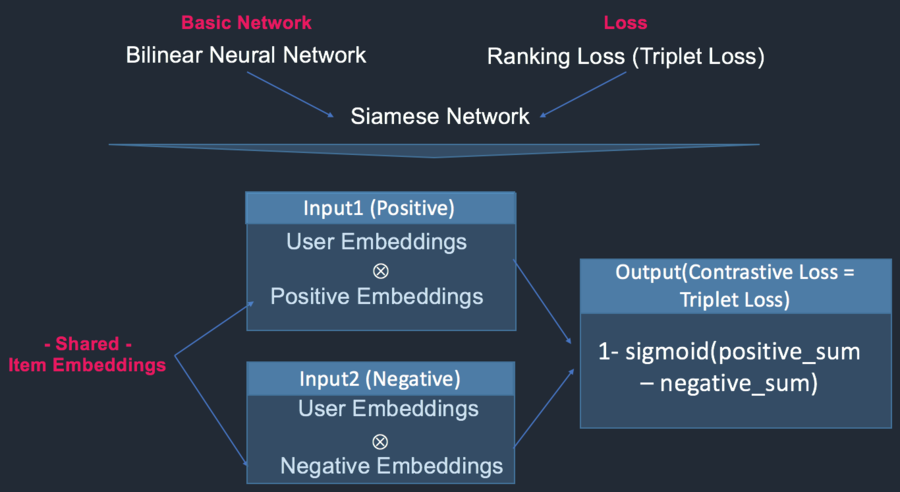Recommendation System by Siamese Network
Recommendations using triplet loss
When both positive and negative items are specified by user, recommendation based on Siamese Network can account such preference and rank positive items higher than negative items. To implements this, I transformed maciej’s github code to account for user specific negative preference. Just as word2vec idea (matrix multiplication that transforms words into corresponding word embeddings), latent factor matrix can be represented by embedding layers. The original idea is building Bilinear Neural Network and Ranking Loss(Triplet Loss), and combine them into Siamese Network architecture siames_blog. The triplet is user, positive items, and negative items.
The below picture demonstrates the way to construct the architecture. Positive and negative item embeddings share a item embedding layer, and each of them are multiplied by a user embedding layer. Although the original code used Movielens100k dataset and randomly selects negative items randomly, which can lead negative items to contain some positive items, I set the negative items with score less than 2 and positive items greater than 5.
Since negative and positive embedding layers share the same item embedding layer, the size of them should be equal. To suffice the deficient amount of negative items, I randomly select items from the recordings 3 and put them into negative items. Finally, The network is built upon Keras backedn Tensorflow. The final outcomes with 20 epcoh shows 82% of AUC(Area Under Curve of ROC curve).

Specific implementation
Data import
import numpy as np
import itertools
import os
import requests
import zipfile
import scipy.sparse as sp
from sklearn.metrics import roc_auc_score
def download_movielens(dest_path):
url = 'http://files.grouplens.org/datasets/movielens/ml-100k.zip'
req = requests.get(url, stream=True)
with open(dest_path, 'wb') as fd:
for chunk in req.iter_content():
fd.write(chunk)
def get_raw_movielens_data():
path = '/path/to/data/saved/movielens.zip'
if not os.path.isfile(path):
download_movielens(path)
with zipfile.ZipFile(path) as datafile:
return (datafile.read('ml-100k/ua.base').decode().split('\n'),
datafile.read('ml-100k/ua.test').decode().split('\n'))Data Pre-Processing
def parse(data):
for line in data:
if not line:
continue
uid, iid, rating, timestamp = [int(x) for x in line.split('\t')]
yield uid, iid, rating, timestamp
def build_interaction_matrix(rows, cols, data):
mat_pos = sp.lil_matrix((rows, cols), dtype=np.int32)
mat_neg = sp.lil_matrix((rows, cols), dtype=np.int32)
mat_mid = sp.lil_matrix((rows, cols), dtype=np.int32)
for uid, iid, rating, timestamp in data:
if rating >= 5.0:
mat_pos[uid, iid] = 1.0
elif rating <= 2.0:
mat_neg[uid, iid] = 1.0
elif rating == 3.0:
mat_mid[uid, iid] = 1.0
possum = mat_pos.sum(); negsum = mat_neg.sum();
# Sampling negative index not included from positive & negatively indicated one
# Sampling deficient amount from the mat_mid value == 1
b = mat_mid.toarray() == 1.0
index = np.column_stack(np.where(b))
# Shuffle allindex and get the first N(deficient) amount location
np.random.shuffle(index)
if negsum < possum:
deficient = (possum - negsum)
allindex = index[:deficient, ]
# Asgign value into mat_neg where mat_mid occurs
for idx, val in enumerate(allindex):
mat_neg[val[0] , val[1]] = 1.0
possum = mat_pos.sum(); negsum = mat_neg.sum()
if possum != negsum:
print("Number of Positive and negative doesn't match!!")
pass
elif possum > negsum:
deficient = (negsum - possum)
allindex = index[:deficient, ]
# Asgign value into mat_neg where mat_mid occurs
for idx, val in enumerate(allindex):
mat_pos[val[0], val[1]] = 1.0
return ( mat_pos.tocoo(), mat_neg.tocoo() )
def get_movielens_data():
train_data, test_data = get_raw_movielens_data()
uids = set()
iids = set()
for uid, iid, rating, timestamp in itertools.chain(parse(train_data),parse(test_data)):
uids.add(uid)
iids.add(iid)
rows = max(uids) + 1
cols = max(iids) + 1
train_pos , train_neg = build_interaction_matrix(rows, cols, parse(train_data))
test_pos , test_neg = build_interaction_matrix(rows, cols, parse(test_data))
return (train_pos , train_neg, test_pos , test_neg)Keras Model Implementation
from keras import backend as K
from keras.models import Model, Sequential
from keras.layers import Embedding, Flatten, Input, Convolution1D ,merge
from keras.optimizers import Adam
def bpr_triplet_loss(X):
positive_item_latent, negative_item_latent, user_latent = X
# BPR loss
loss = 1.0 - K.sigmoid(
K.sum(user_latent * positive_item_latent, axis=-1, keepdims=True) -
K.sum(user_latent * negative_item_latent, axis=-1, keepdims=True))
return loss
def identity_loss(y_true, y_pred):
return K.mean(y_pred - 0 * y_true)
def build_model(num_users, num_items, latent_dim):
# Input
positive_item_input = Input((1, ), name='positive_item_input')
negative_item_input = Input((1, ), name='negative_item_input')
user_input = Input((1, ), name='user_input')
# Embedding
# Shared embedding layer for positive and negative items
item_embedding_layer = Embedding( num_items, latent_dim, name='item_embedding', input_length=1)
positive_item_embedding = Flatten()(item_embedding_layer(positive_item_input))
negative_item_embedding = Flatten()(item_embedding_layer(negative_item_input))
user_embedding = Flatten()(Embedding( num_users, latent_dim, name='user_embedding', input_length=1)(user_input))
# Loss and model
loss = merge(
[positive_item_embedding, negative_item_embedding, user_embedding],
mode=bpr_triplet_loss,
name='loss',
output_shape=(1, ))
model = Model(
input=[positive_item_input, negative_item_input, user_input],
output=loss)
model.compile(loss=identity_loss, optimizer=Adam())
return model
